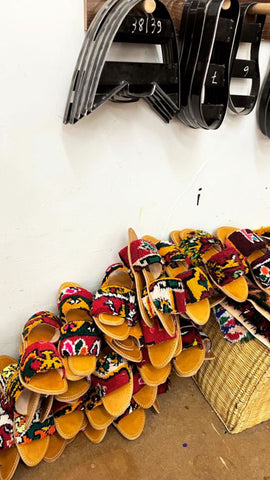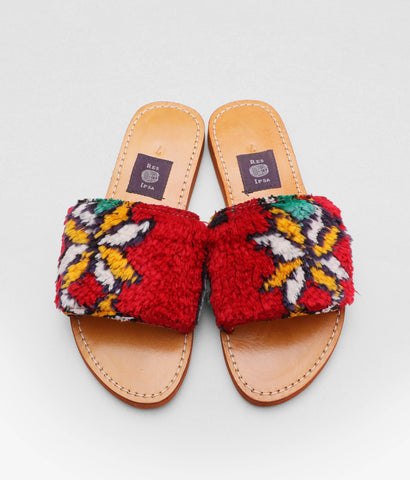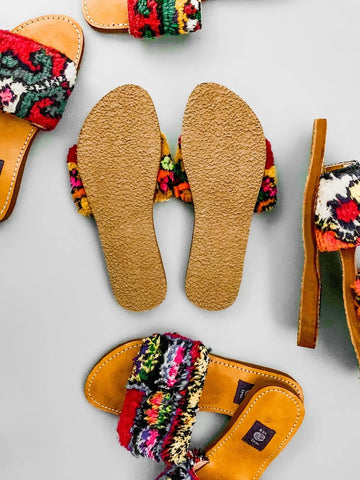Marrakech, Morocco - In 2020, we expanded on our dreams in major ways: offering more products across the brand and engaging with our travel lifestyle in new ways. We decided that in order to create the products we love in a sustainable way, we must control the means of production. We set our intentions. We followed our hearts. Our travels led us to Morocco, and we built our own atelier (French for "workshop") in Marrakech to supply our retail stores and website with apparel and home goods.
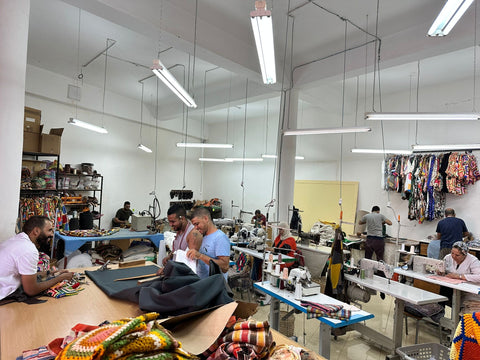 Res Ipsa Marrakech atelier
Res Ipsa Marrakech atelier
One of our first Moroccan travel trips, we discovered that just about 40 miles south of our atelier, the Ourika Valley opens up an ancient landscape, an old set of traditions, and a community of people -- the Berber tribe -- that have endured there for over thousands of years. To this day, the Berber people still remain a backbone of the Moroccan economy and are known worldwide for their influence on a wide array of production, largely done by hand in the High Atlas mountains, including rugs, textiles, jewelry, and pottery.
We wanted to share a brief but rich history of the Berber Tribe, the Berber Tribe's connections to Marrakech and the Ourika Valley, and explore our shared growing connections made possible over the past three years post-building our Res Ipsa Marrakech atelier. We feel this blog can provide you with a fun bit of story-telling and background knowledge into a select few product offerings -- our Moroccan rug sandals and Boucherouite rugs -- made from handwoven Berber rugs in the High Atlas mountains. And finally, we hope this blog builds on one of our core beliefs:
- We believe that every person should travel as far as they can as often as they can.
We hope this travel blog might inspire you to travel -- be it to Morocco -- or any place in the world that peaks your curiosity. Enjoy reading!
Berber Tribe
Nestled in the heart of Morocco, the Berber tribe, also known as the Amazigh people, boasts a rich and ancient history that predates even the Arab and Islamic influences in the region.
A Brief History on the Berber Tribe and Marrakech:
-
Ancient Origins: The Berbers are among the world's oldest indigenous groups, with a history that can be traced back over 5,000 years. They are the original inhabitants of North Africa and have inhabited the region long before the Arab conquest.
-
Diverse Languages and Cultures: The Berbers speak various Berber languages, with Tamazight being the most widely spoken. These languages are distinct from Arabic and reflect the diverse cultures and traditions of different Berber communities.
-
Traditional Lifestyle: Berber communities have traditionally led a semi-nomadic or rural lifestyle, with agriculture and livestock playing significant roles. They maintain strong communal bonds within their villages and share the responsibilities of daily life.
-
Cultural Identity: Berbers have a unique cultural identity deeply rooted in their connection to the land and nature. Many Berber festivals, rituals, and beliefs are closely tied to the natural world, and they have a rich tradition of storytelling, music, and dance. They also are experts when it comes to handwoven and handmade goods, including rugs, textiles, jewelry, and pottery.

Historic Marrakech Medina
- Historical Origins: Marrakech was founded by the Almoravid dynasty in the 11th century, a dynasty that had Berber roots. The Almoravids, originally from the Sahara region and with strong Berber connections, played a crucial role in the establishment of Marrakech as a major city.
-
Berber Heritage: Despite the city's historical significance, Marrakech has always had a strong Berber influence. Many of the city's residents and inhabitants are of Berber descent, and the Berber culture has left an indelible mark on the city's traditions, art, and daily life.
-
Language: While Arabic is the official language of Marrakech, you can still hear Berber languages spoken, particularly in the homes and communities of those who identify as Berbers. This linguistic diversity reflects the historical coexistence of Arabic and Berber cultures.
-
Cultural Expression: The city of Marrakech is known for its vibrant cultural scene, including traditional music, dance, and art, which often feature elements of Berber culture. The Gnaoua music, for instance, is a fusion of Berber, sub-Saharan African, and Arabic influences, and it is celebrated in Marrakech.
-
Economic Ties: Marrakech serves as a hub for trade and commerce, and Berber communities from the surrounding areas often come to the city to sell their products and wares. The famous markets, or souks, of Marrakech feature a wide array of Berber handmade goods.
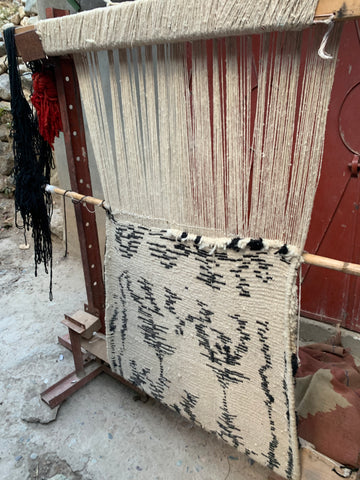
Handmade Berber rugs on a loom.
Beber Motifs
Berber motifs refer to the traditional decorative patterns, symbols, and designs used by the Berber people, who are indigenous to North Africa, particularly in regions such as Morocco, Algeria, Tunisia, Libya, and parts of Mali and Niger. Berber motifs are rich in symbolism and have been used for centuries in various aspects of Berber culture, including their art, textiles, jewelry, and architecture. Here are some common Berber motifs and their meanings:
-
Zigzags and Diamonds: Zigzag and diamond-shaped patterns are prevalent in Berber textiles and rugs. They are often associated with protection and warding off evil spirits. The zigzag patterns represent snakes, which are believed to have protective qualities.
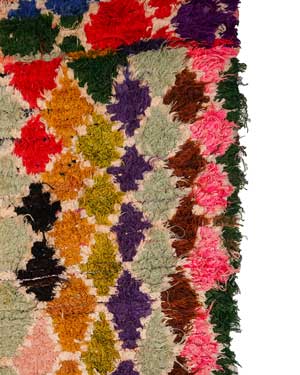 Shop Res Ipsa Moroccan Boucherouite Rug No. 39 (featuring Diamond motif)
Shop Res Ipsa Moroccan Boucherouite Rug No. 39 (featuring Diamond motif) -
Tribal Symbols: Different Berber tribes have their own unique symbols and motifs, which can vary in meaning. These symbols are often used in tattoos, jewelry, and clothing to represent tribal identity and heritage.
-
Amazigh (Berber) Script: The Tifinagh script is the traditional script of the Berber people. It is often used decoratively to write words or phrases, and it represents the Berber culture and language.
-
Hand of Fatima (Khamsa): The Hand of Fatima, also known as the Khamsa, is a symbol of protection and is widely used in Berber jewelry and art. It is believed to ward off the evil eye and bring good luck.
-
Geometric Patterns: Berber art often features intricate geometric patterns, including squares, triangles, and hexagons. These patterns are believed to represent balance and harmony in the universe.
-
Ladders and Crosses: Ladder and cross motifs can symbolize spirituality and the connection between heaven and earth. They are often found in Berber textiles and jewelry.
-
Sun and Stars: The sun and stars hold significance in Berber culture. The sun symbolizes light, life, and energy, while stars represent guidance and direction.
-
Animal Motifs: Berber art may include depictions of animals, such as camels, goats, and birds, which are important in Berber daily life. These motifs can symbolize fertility, sustenance, and connection to nature.
-
Tattoos: Berber women, in particular, have a tradition of tattooing intricate symbols and motifs on their faces and bodies. These tattoos can have personal and cultural significance.
-
Color Symbolism: Colors in Berber motifs can carry specific meanings. For example, red may symbolize strength and vitality, while blue can represent protection.
Berber motifs are a reflection of the rich cultural and historical heritage of the Berber people. They are not only aesthetically pleasing but also hold deep cultural, spiritual, and symbolic meanings that have been passed down through generations. These motifs continue to be an integral part of Berber art and identity.
Ourika Valley and the Berber Tribe
A Brief History on the Enchanting Ourika Valley:
-
Location and Landscape: Ourika Valley, situated approximately 60 kilometers from Marrakech, offers a stunning natural landscape. It's surrounded by the majestic High Atlas Mountains, with the Ourika River flowing through it. The valley is known for its lush greenery, terraced farms, and picturesque Berber villages.
-
Berber Communities: The Ourika Valley is home to numerous Berber villages, where you can experience the authentic culture and lifestyle of the local Berber people. These villages, like Setti Fatma, provide insights into Berber traditions, art, and crafts.
The Berber tribe and the Ourika Valley are intricately intertwined, with each illuminating the beauty and depth of the other. The Berber people's rich history, unique traditions, and enduring cultural identity enrich the enchanting landscapes and experiences that the valley has to offer.
A Common Thread: the Berber Tribe, and the Ourika Valley and the Res Ipsa Marrakech Atelier
We often get asked, "Why Marrakech?" meaning why build an atelier in Marrakech? For starters, we respond with a narrowed down response of all the above: Marrakech is magic. On top of that, we love traveling to Marrakech. There is no other place like it.
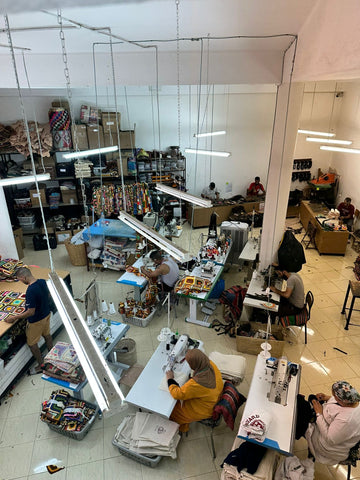 Res Ipsa Marrakech Atelier
Res Ipsa Marrakech Atelier
Another reason is we built our factory as space to create well-made products in a responsible, sustainable way. In the process, we employ local artisans from the greater-Marrakech community. From creating our crochet collections which begins with crochet handmade in a co-op of 30-40 local women in Marrakech to sourcing the finest vintage rugs in the High Atlas mountains, we work hand-in-hand with local Moroccan communities. Controlling the tailoring process from start-to-finish, using upcycled materials, and creating only what we need minimizes our impact. A lot of the raw materials we wanted to work with we could find in Marrakech and the surrounding communities.
We make a lot of our products from vintage Boucherouite rugs. The name boucherouite (pronounced "boo-shay-reet”) is derived from a Moroccan-Arabic word that means a "scrap" because it is made from excess yarn and recycled carpets. The result is an extravagant rug that is bright, vibrant, and textured.
Our Moroccan rug sandals are handmade in our Marrakech atelier. Our sandals are made from repurposed bourcherouite rugs. We source these 50-to-100 year old rugs from the Berber tribe.
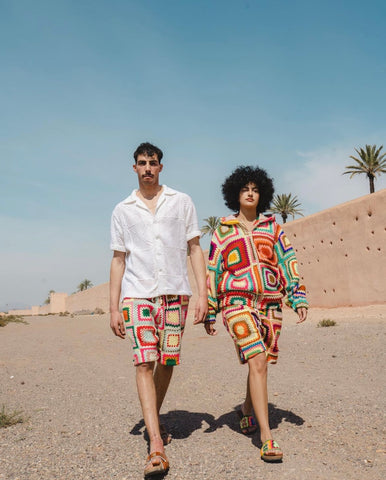
Our rug sandals are entirely handmade, featuring a genuine leather lining, a leather sole, and a thin layer of protective rubber on the sole. Because each pair is made from a vintage, handwoven rug, every pair we make will be completely unique and one-of-a-kind, never to be reproduced.
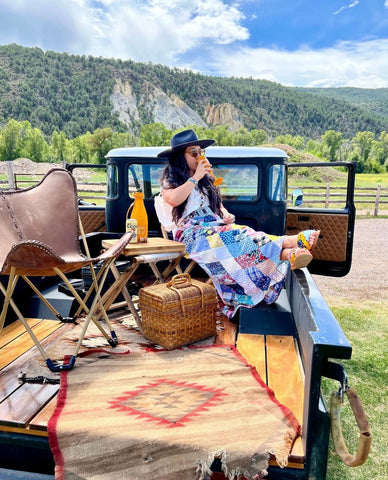
Our sandals’ silhouette is elegant and embraces versatility and simplicity. We find they pair well with almost any wardrobe. Each pair is lightweight and can easily slip on to get out the door in seconds, so wear them casually with a faded Vintage T-shirt and a distressed pair of Vintage 501 Denim. Just as well, dress them up in a jumpsuit, a skirt, or a dress for dinner and an evening out.
Shop Boucherouite Rug
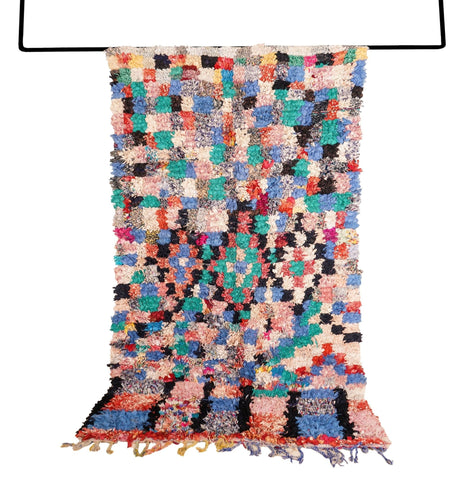
We are excited to offer vintage boucherouite rugs that we hand-selected from the Medina in Marrakech. The gorgeous wool rugs were made by members of the Berber tribe from the Ourika Valley in the High Atlas mountains. Ourika boucherouite rugs are are handwoven for use in the home using undyed organic wool with Berber motifs.
Shop Boucherouite Runners

---
#OurBrandisTravel



